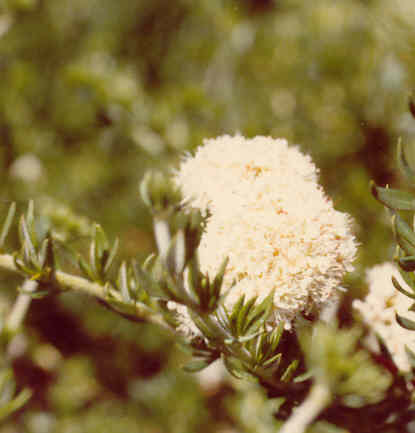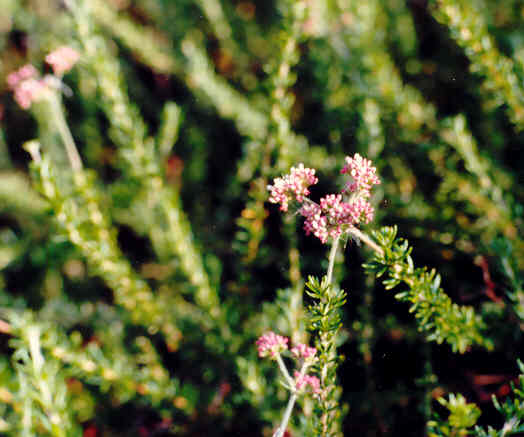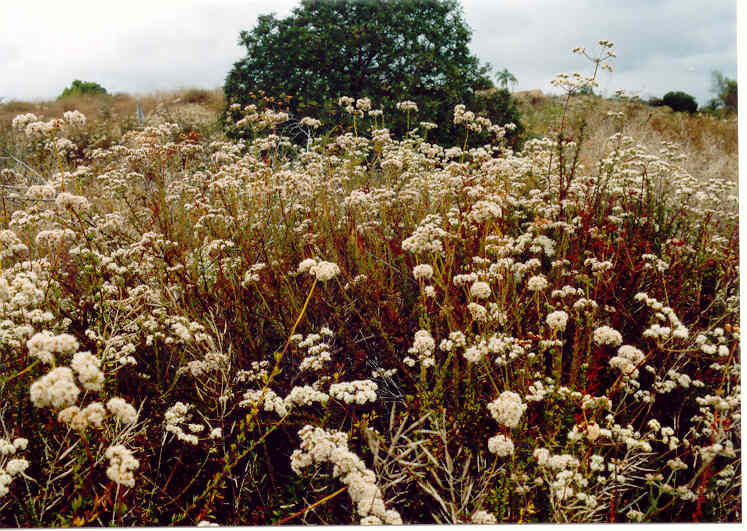
Eriogonum fasciculatum Benth. var. fasciculatum
 |
Eriogonum fasciculatum Benth. var. fasciculatum
Polygonaceae (Buckwheat Family)NativeCalifornia Buckwheat |
April Photo
Plant Characteristics:
Low spreading shrubs, the stems +/- decumbent, 6-12 dm. long, branched,
leafy; branchlets loosely pubescent to subglabrous, ending in leafless peduncles
3-10 (-15) cm. long, bearing +/- open cymose infl. with many capitate clusters
at the tips; lvs. numerous, fascicled, oblong-linear to linear-oblanceolate,
green and glabrate above, white-woolly beneath, 6-15 mm. long, strongly
revolute; invols. prismatic, 3-4 mm. high, glabrous, with 5 short acute teeth;
calyx white or pinkish, ca. 3 mm. long, nearly or quite glabrous without, the
outer segms. broadly elliptic, the inner obovate; fils. subglabrous basally;
aks. lance-ovoid, shining, ca. 2 mm. long.
Habitat:
Dry slopes and canyons near the immediate coast; Coastal Sage Scrub;
Santa Barbara to n. L. Calif. Blooms
much of the year.
Name:
Greek, erion, wool, and gonu joint or knee, the type of the
genus E. tomentosum. (Munz, Flora
So. Calif. 677). Fasciculatum,
Latin word meaning "bundles" and describes the growth habit of the
leaves. (Dale 158).
General:
Very common in the study area. Photographed on North Star Beach and in
big Canyon. (my comments).
Eriogonum inflatum was used by the Death Valley Indians for medicine pipes. E.
umbellatum was used by the Nevada Indians as a tea for colds.
(Murphy 37). Many of the species are worth eating,
none are known to be poisonous. The
stems may be eaten raw or cooked before they have flowered.
(Kirk 231).
The dry heads or leaves of E. fasciculatum are used in decoctions
for headaches and stomach disorders. (Heizer
& Elsasser 130).
The seeds do not need to be winnowed.
The flowers and seeds can be ground together.
(lecture by Charlotte Clarke, author of Edible and
Useful Plants of California, April 1987.
While it has not been investigated physiologically, seasonal leaf
dimorphism (the existence of two distinct forms of the same organ on the same
plant) has been observed in a large number of other drought-deciduous subshrubs
in California. The presence of such
dimorphic leaves may be variable within a genus. California buckwheat, with semi-evergreen, sclerophyllus
leaves, does not exhibit this characteristic, while Eriogonum cenereum,
with more mesophytic (a plant requiring medium conditions of moisture and
dryness, intermediate between a hydrophyte and a xerophyte) leaves, does have
seasonal leaf dimorphism. Most of
the species with seasonal leaf dimorphism lose all of their leaves with full
levels of summer drought. (Rundel,
Philip W. "Structure and
Function in California Chaparral."
FREMONTIA, A Journal of
the California Native Plant Society. October
1986. p. 7). For additional information on chaparral and drought-deciduous
plants see Lotus scoparius, Heteromeles arbutifolia, Encelia californica,
Rhus integrifolia and Artemisia californica.
Delfina Cuero, a Kumeyaay or Southern Diegueno Indian, made the following
comments about Eriogonum fasciculatum in her autobiography:
"We gathered the flowers or roots and boiled them to drink as tea for stomach trouble;
roots are best. The tops are eaten
for food." (Shipek 90).
The wild buckwheats, known botanically as the genus Eriogonum, are
American relatives of the true buckwheat, Fagopyrum, of Asia, widely
grown as a food crop. Theirs is an
enormous genus, currently thought to contain about 250 species.
Well over 100 species and many subspecies and varieties are listed for
California in the new Jepson Manual. (Smith,
Nevin "Growing Natives: Buckwheats."
FREMONITA, A Journal of the California Native Plant Society. April 1995. p.
25-30).
Text Ref:
Hickman, Ed. 872; Munz, Flora So. Calif. 684; Roberts 33.
Photo Ref:
Dec 1 82 #23A,32A; Mar 3 85 # 14,15.
Identity: by R. De Ruff, confirmed by F. Roberts.
Computer Ref: Plant Data 255.
Have plant specimen.
Last edit 6/1/03.
 |
 |
December Photo June Photo